ACTIVE LEARNING A POWERPOINT TUTORIAL
互动式教学Interactive Learning
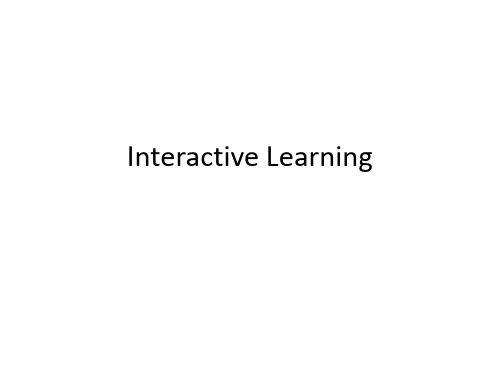
By the end of this session, you should be able to…
• build up connections between interactive teaching and student learning
• plan a lesson using interactive teaching approach • be aware of possible tools/strategies and choose appropriate ones to achieve designated learning outcomes
References
• Morris, G. (2011). Exploring Interactive Learning. (Certificate Stage 1 course PPT). CETL, HKU.
• Biggs, J. & Tang, C. (2011) Teaching for quality learning at university: What the student does. Maidenhead: McGraw-Hill/Society for Research into Higher Education/Open University Press, 2011. • Bligh, D. A. (1972). What’s the use of lectures? Harmondsworth: Penguin. • Lyman, F. (1987). Think-Pair-Share: An expanding teaching technique. MAA-CIE Cooperative News, v. 1, p. 1–2
高中英语必修第三册课件Unit 9 Learning Lesson 1 Active Learning-北师大版(2019)

2. What is active learning? Active learning is training ourselves to be better learners, to actively take part in the learning process.
and learning effects for teach
s u g g e s t i o nL.earning actions:
_______________________________ _
1. Listen to the outer voice
Reasons: ___________________________ Nhomakorabea___ _
● keep
● risk
● end up ● stop
doing
● try
● cannot help
Verbs followed by infinitive
need attempt try refuse
to do
—Have you spoken to Rachel?
—No. I tried to call her but the line was
Learning effects: _______________________________ _
2. Argue with your inner voice
active learning教案
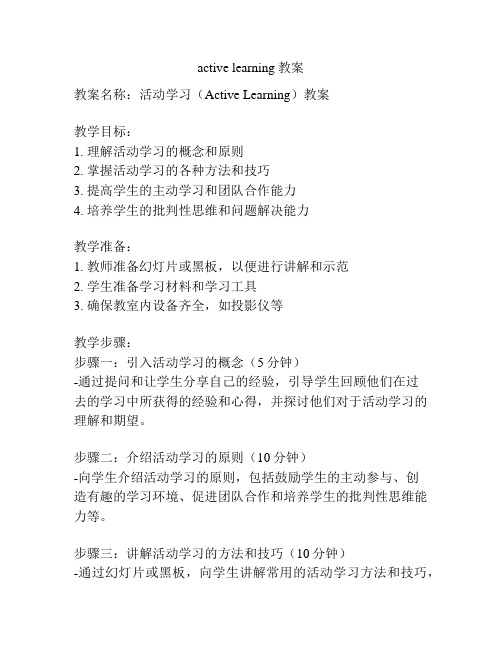
active learning教案教案名称:活动学习(Active Learning)教案教学目标:1. 理解活动学习的概念和原则2. 掌握活动学习的各种方法和技巧3. 提高学生的主动学习和团队合作能力4. 培养学生的批判性思维和问题解决能力教学准备:1. 教师准备幻灯片或黑板,以便进行讲解和示范2. 学生准备学习材料和学习工具3. 确保教室内设备齐全,如投影仪等教学步骤:步骤一:引入活动学习的概念(5分钟)-通过提问和让学生分享自己的经验,引导学生回顾他们在过去的学习中所获得的经验和心得,并探讨他们对于活动学习的理解和期望。
步骤二:介绍活动学习的原则(10分钟)-向学生介绍活动学习的原则,包括鼓励学生的主动参与、创造有趣的学习环境、促进团队合作和培养学生的批判性思维能力等。
步骤三:讲解活动学习的方法和技巧(10分钟)-通过幻灯片或黑板,向学生讲解常用的活动学习方法和技巧,如小组讨论、角色扮演、实地考察、问题解决等,并给予相关的示范和解释。
步骤四:组织学生进行实际活动学习(20分钟)-根据教学内容,分组或分配任务给学生,让他们进行实际的活动学习。
教师可以提供必要的指导和支持,并监督学生的学习进展。
步骤五:总结和评价(10分钟)-请学生就本次活动学习进行总结和评价,表达自己的学习收获和体会,并互相交流和讨论。
教师可以适时给予鼓励和肯定。
步骤六:布置下一步学习任务(5分钟)-根据学生的学习情况和需求,布置下一步的学习任务,并鼓励学生继续发挥主动性,展开更多的学习活动。
教学扩展:1. 教师可以采用不同的评价方法,如问卷调查、小组报告等,来评价学生的活动学习效果。
2. 教师还可以鼓励学生自主选择和设计活动学习任务,以便更好地满足学生的学习需求和兴趣。
3. 教师可以邀请学生分享他们的活动学习经验和成果,并鼓励他们互相学习和启发。
教学反思:活动学习是一种重要的教学方法,可以激发学生的学习兴趣和主动性,培养他们的合作精神和解决问题的能力。
行动学习(Action Learning)中英文对照课程ppt
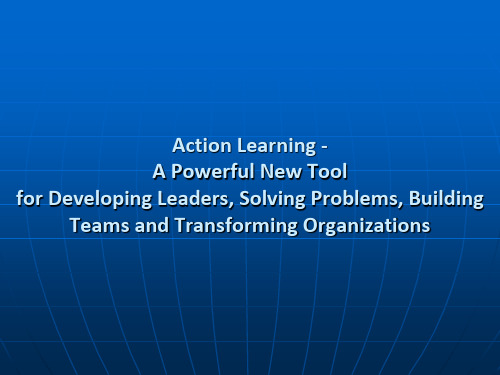
行动学习的两大基本规则与指南
1. 只针对问题表达看法; 任何人都可以提问。
2. 每当行动学习教练发现 了学习机遇,都有权进 行干预。
行动学习的力量与好处
解决复杂问题 提升关键领导力的能力 建设强大团队 个人能不断地进行有价
值的学习 创造一种能够应对变化
与不断学习的组织文化 提高系统性思维能力与
创造力
Action Learning - Worldwide
Sodexho Novartis Siemens Boeing Caterpillar Microsoft Nokia World Bank Hong Kong Transit General Electric DuPont Samsung American University Constellation Energy Goodrich
2. Action Learning Group
4-8 members to maximize creativity
From within and outside the organization
Diverse so as to obtain fresh viewpoints (Pizza man)
Learning during and after action
什么是行动学习?
几人一组共同解决一 些实际问题,采取行 动,从行动中学习的 一种过程
从行动中学习 做中学,做后学
Power and Benefits of Action Learning
Activelearningis...

Active LearningActive learning is generally defined as any instructional method that engages students in the learning process. In short, active learning requires students to do meaningful learning activities and think about what they are doing. While this definition could include traditional activities such as homework, in practice, active learning refers to activities that are introduced into the classroom. The core elements of active learning are student activity and engagement in the learning process. Active learning is often contrasted to the traditional lecture where students passively receive information from the instructor.In the traditional approach to college teaching, most class time is spent with the professor lecturing and the students watching and listening. The students work individually on assignments, and cooperation is limited.Such teacher-centered instructional methods have repeatedly been found inferior to instruction that involves active learning, in which students solve problems, answer questions, formulate questions of their own, discuss, explain, debate, or brainstorm during class.Example "active" activities include: class discussion, small group discussion, debate, posing questions to the class, think-pair-share activities, short written exercises and polling the class (Bonwell and Eison, 1991).A class discussion may be held in person or in an online environment. It is best that these discussions be centered on an open-ended (occasionally controversial) topic (e.g. one that has no right or wrong answer).A small group discussion is a similar activity between individual, groups, or teams of individuals. A presidential debate is a common debate format. But these also may center around controversial or political topic.A think-pair-share activity is when learners take a minute to ponder the previous lesson, later to discuss it with one or more of their peers, finally to share it with the class a part of a formal discussion.A short written exercise that is often used is the "one minute paper." In this exercise students are asked to summarize the day's discussion in a short paper to be turned in before the end of class. This is a good way to review materials.The following short article has been repeatedly cited in the resources I have reviewed (note the citation above) and may be helpful in identifying those things you already do in the classroom that are typical of active learning. Additionally, the essay may provide some helpful hints on increasing active learning in your courses.Active Learning: Creating Excitement in the ClassroomSubscribe toNTLFLibraryERICDigestsby Charles C. Bonwell and James A. EisonResearch consistently has shown that traditional lecturemethods, in which professors talk and students listen, dominatecollege and university classrooms. It is therefore important toknow the nature of active learning, the empirical research on itsuse, the common obstacles and barriers that give rise to facultymembers' resistance to interactive instructional techniques, andhow faculty, faculty developers, administrators, and educationalresearchers can make real the promise of active learning.WHAT IS ACTIVE LEARNING AND WHY IS ITIMPORTANT?Surprisingly, educators' use of the term "active learning" hasrelied more on intuitive understanding than a commondefinition. Consequently, many faculty assert that all learning isinherently active and that students are therefore activelyinvolved while listening to formal presentations in theclassroom. Analysis of the research literature (Chickering andGamson 1987), however, suggests that students must do morethan just listen: They must read, write, discuss, or be engaged insolving problems. Most important, to be actively involved,students must engage in such higher-order thinking tasks asanalysis, synthesis, and evaluation. Within this context, it isproposed that strategies promoting active learning be defined asinstructional activities involving students in doing things andthinking about what they are doing.Use of these techniques in the classroom is vital because of theirpowerful impact upon students' learning. For example, severalstudies have shown that students prefer strategies promotingactive learning to traditional lectures. Other research studiesevaluating students' achievement have demonstrated that manystrategies promoting active learning are comparable to lecturesin promoting the mastery of content but superior to lectures inpromoting the development of students' skills in thinking andwriting. Further, some cognitive research has shown that asignificant number of individuals have learning styles bestserved by pedagogical techniques other than lecturing.Therefore, a thoughtful and scholarly approach to skillfulteaching requires that faculty become knowledgeable about themany ways strategies promoting active learning have beensuccessfully used across the disciplines. Further, each faculty member should engage in self-reflection, exploring his or her personal willingness to experiment with alternative approaches to instruction.HOW CAN ACTIVE LEARNING BE INCORPORATED IN THE CLASSROOM?The modification of traditional lectures (Penner 1984) is one way to incorporate active learning in the classroom. Research has demonstrated, for example, that if a faculty member allows students to consolidate their notes by pausing three times for two minutes each during a lecture, students will learn significantly more information (Ruhl, Hughes, and Schloss 1987). Two other simple yet effective ways to involve students during a lecture are to insert brief demonstrations or short, ungraded writing exercises followed by class discussion. Certain alternatives to the lecture format further increase student level of engagement: (1) the feedback lecture, which consists of two minilectures separated by a small-group study session built around a study guide, and (2) the guided lecture, in which students listen to a 20- to 30-minute presentation without taking notes, followed by their writing for five minutes what they remember and spending the remainder of the class period in small groups clarifying and elaborating the material. Discussion in class is one of the most common strategies promoting active learning_with good reason. If the objectives of a course are to promote long-term retention of information, to motivate students toward further learning, to allow students to apply information in new settings, or to develop students' thinking skills, then discussion is preferable to lecture (McKeachie et al. 1986). Research has suggested, however, that to achieve these goals faculty must be knowledgeable of alternative techniques and strategies for questioning and discussion (Hyman 1980) and must create a supportive intellectual and emotional environment that encourages students to take risks (Lowman 1984).Several additional strategies promoting active learning have been similarly shown to influence favorably students' attitudes and achievement. Visual-based instruction, for example, can provide a helpful focal point for other interactive techniques. In-class writing across the disciplines is another productive way to involve students in doing things and thinking about the things they are doing. Two popular instructional strategies based onproblem-solving model include the case study method of instruction and Guided Design. Other active learning pedagogies worthy of instructors' use include cooperative learning, debates, drama, role playing and simulation, and peer teaching. In short, the published literature on alternatives to traditional classroom presentations provides a rich menu of different approaches faculty can readily add to their repertoire of instructional skills. WHAT ARE THE BARRIERS?To address adequately why most faculty have not embraced recent calls for educational reform, it is necessary first to identify and understand common barriers to instructional change, including the powerful influence of educational tradition; faculty self-perceptions and self-definition of roles; the discomfort and anxiety that change creates; and the limited incentives for faculty to change.But certain specific obstacles are associated with the use of active learning including limited class time; a possible increase in preparation time; the potential difficulty of using active learning in large classes; and a lack of needed materials, equipment, or resources.Perhaps the single greatest barrier of all, however, is the fact that faculty members' efforts to employ active learning involve risk--the risks that students will not participate, use higher-order thinking, or learn sufficient content, that faculty members will feel a loss of control, lack necessary skills, or be criticized for teaching in unorthodox ways. Each obstacle or barrier and type of risk, however, can be successfully overcome through careful, thoughtful planning.WHAT CONCLUSIONS SHOULD BE DRAWN AND RECOMMENDATIONS MADE?The reform of instructional practice in higher education must begin with faculty members' efforts. An excellent first step is to select strategies promoting active learning that one can feel comfortable with. Such low-risk strategies are typically of short duration, structured and planned, focused on subject matter that is neither too abstract nor too controversial, and familiar to both the faculty member and the students.Faculty developers can help stimulate and support faculty members' efforts to change by highlighting the instructionalimportance of active learning in the newsletters and publications they distribute. Further, the use of active learning should become both the subject matter of faculty development workshops and the instructional method used to facilitate such programs. And it is important that faculty developers recognize the need to provide follow-up to, and support for, faculty members' efforts to change.Academic administrators can help these initiatives by recognizing and rewarding excellent teaching in general and the adoption of instructional innovations in particular. Comprehensive programs to demonstrate this type of administrative commitment (Cochran 1989) should address institutional employment policies and practices, the allocation of adequate resources for instructional development, and the development of strategic administrative action plans.Equally important is the need for more rigorous research to provide a scientific foundation to guide future practices in the classroom. Currently, most published articles on active learning have been descriptive accounts rather than empirical investigations, many are out of date, either chronologically or methodologically, and a large number of important conceptual issues have never been explored. New qualitative and quantitative research should examine strategies that enhance students' learning from presentations; explore the impact of previously overlooked, yet educationally significant, characteristics of students, such as gender, different learning styles, or stage of intellectual development; and be disseminated in journals widely read by faculty.In retrospect, it appears that previous classroom initiatives and written materials about active learning have all too often been isolated and fragmented. The resulting pedagogical efforts have therefore lacked coherence, and the goal of interactive classrooms has remained unfulfilled. Through the coordinated efforts of individual faculty, faculty developers, academic administrators, and educational researchers, however, higher education in the coming decade CAN make real the promise of active learning!SELECTED REFERENCES Chickering, Arthur W., and Zelda F. Gamson. March 1987. "Seven Principles for Good Practice." AAHE Bulletin 39: 3-7.ED 282 491. 6 pp. MF-01; PC-01.Cochran, Leslie H. 1989. Administrative Commitment to Teaching. Cape Girardeau, Mo.: Step Up, Inc.Hyman, Ronald T. 1980. Improving Discussion Leadership. New York: Columbia Univ., Teachers College Press.Lowman, Joseph. 1984. Mastering the Techniques of Teaching. San Francisco: Jossey-Bass.McKeachie, Wilbert J., Paul R. Pintrich, Yi-Guang Lin, and David A.F. Smith. 1986. Teaching and Learning in the College Classroom: A Review of the Research Literature. Ann Arbor: Regents of The Univ. of Michigan. ED 314 999. 124 pp. MF-01; PC-05.Penner, Jon G. 1984. Why Many College Teachers Cannot Lecture. Springfield, Ill.: Charles C. Thomas.Ruhl, Kathy L., Charles A. Hughes, and Patrick J. Schloss. Winter 1987. "Using the Pause Procedure to Enhance Lecture Recall." Teacher Education and Special Education 10: 14-18. ED340272 Sep 91 Active Learning: Creating Excitement in the Classroom. ERIC Digest.ERIC Clearinghouse on Higher Education, Washington, D.C.; George Washington Univ., Washington, D.C.The eight issue series is available through subscription for $120.00 per year ($140.00 outside the U.S.). Subscriptions begin with Report 1 and conclude with Report 8 of the current series year. Single copies, at $24.00 each, can be ordered by writing to: ASHE-ERIC Higher Education Reports, The George Washington University, One Dupont Circle, Suite 630, Washington, DC 20036-1183, or by calling (800) 773-3742. Call for a copy of the ASHE-ERIC Higher Education Reports Catalog or visit or web site /~eriche.[Home][Site Map][Search][Subscribe][About NTLF][Current Issue][Previous Issues][Discussion Forum][Special Features][Library][Sweepstakes]� Copyright 1996-2003. Published by James Rhem & Associates, LLC. (ISSN 1057-2880)All rights reserved worldwide.Web Weaving™ By InfoStreet, Inc.。
《Learning》SectionⅠ PPT课件

Ⅰ.语言知识积累 谈论学习的常用口语
1.Are you busy with your study this term? 你这学期忙吗? 2.Do you have a busy schedule this term?你这学期课程安排紧吗? 3.How many courses do you have this term?你这学期上几门课? 4.I’m afraid the course load is a little too heavy. 恐怕课程负担太重了。 5.I think you’d better carry a little load in the first term.
③__l_e_a_rn__a_b_o_u_t_ new ideas.I’m always ④__cu_r_i_o_u_s_a_b_o_u_t new things.I’m working on a science ⑤___p_r_o_je_c_t____ with my friends.It’s great.I like to ⑥__w_o_r_k__w_i_th___ a partner or do ⑦__g_ro_u_p__w_o_r_k__ after class.My learning ⑧____g_o_a_l_____ is to get into college.And I’m going to enter the country science ⑨__c_o_m__p_e_ti_ti_o_n_ next month.I’m sure I’ll do ⑩_____w__el_l____.
教师联合会PTA(Parent and Teacher Association),以及较具有专业性质的一般坊间教
育机构。
北师大版(2019)英语必修 第三册 Unit 9 Learning-Lesson 1 Active Learning 课件(共19张PPT)

5. Focus on the message
Learning actions: ________________________________
Reasons: ________________________________
Learning effects: ________________________________
Activity 9
Verbs followed by verb-ing form Verbs followed by infinitive
suggest keep risk end up stop try cannot help
doing
Hale Waihona Puke need attempt try refuse
to do
—Have you spoken to Rachel? —No. I tried to call her but the line was busy.
Ask questions
1
Get to the truth
2
Listen to the outer voice
3
Focus on the message
4
Argue with your inner voice
5
Activity 5
Identify the learning actions, reasons and learning effects for
1. What do most people believe about the human brain? Is it true? Most people believe that our brain learns automatically. But, it’s not true.
Unit9LearningLesson1ActiveLearning教学设计-高一下学期英语北师大版

北师大版(2019)必修第三册Unit 9 LearningLesson 1 Active Learning教材分析:北师大版(2019)必修第三册Unit 9 Learning Lesson 1 Active Learning这一课程主要教授了主动学习的概念与方法。
课本采用了对话、文章、问题解答等多种形式呈现。
教学目标:1. 了解主动学习的概念和优势;2. 学会应用一些主动学习的方法和技巧;3. 培养学生自主学习的意识和能力。
教学重点:1. 理解并运用主动学习的理念;2. 学习一些主动学习的方法并能灵活运用。
教学难点:1. 培养学生主动学习的兴趣和热情;2. 引导学生养成主动学习的习惯。
学情分析:高一学生正处于学业压力增大、自主学习意识不足的阶段,对主动学习的概念和方法可能了解不多。
因此,学生需要在课堂上得到充分的引导和激发,以提高他们主动学习的积极性和效果。
教学策略:1. 引导学生了解主动学习的概念和意义,鼓励他们在学习中主动探索、思考和提问;2. 鼓励学生进行合作学习和小组交流,通过互相讨论和分享,促进彼此的理解和进步;3. 设计一些学习任务和活动,培养学生的主动学习能力,如让学生自主策划调查活动、研究主题、制定学习计划等。
教学方法:1. 针对学生的学习特点,采用启发式教学方法,引导学生主动思考和提问;2. 采用情景教学法,通过设计生动的情境,激发学生的学习兴趣和动力;3. 运用案例教学法,通过真实的例子引导学生进行案例分析和解决问题。
导入环节(约5分钟):教学内容:介绍主题和目标,激发学生的学习兴趣。
教学活动:先向学生介绍本节课的主题是"主动学习",并解释这是一种高效的学习方法。
然后向学生提出问题:你们认为什么样的学习方法更有效,为什么?引导学生思考,并鼓励他们分享自己的观点和经验。
课堂互动(约35分钟):教学内容:介绍有关主动学习的概念和方法。
教学活动:1. 观看视频:播放一个关于主动学习的视频,让学生通过视觉和听觉的方式来了解主动学习的理念和实践方法。
【新教材】9.1 Active Learning 教学设计-北师大版高中英语必修第三册
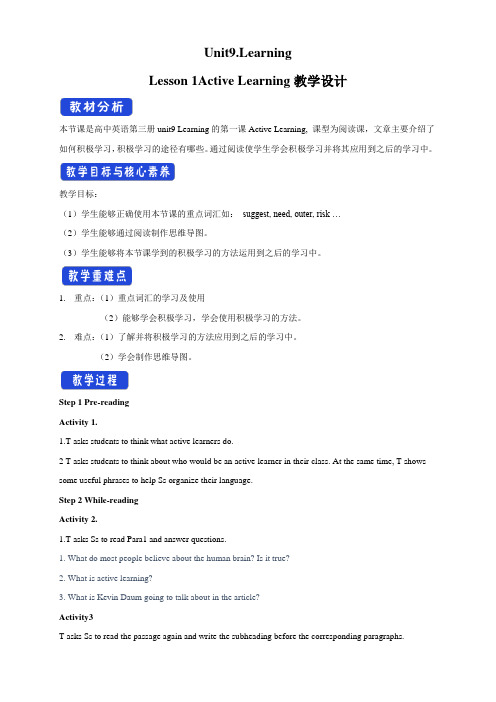
Unit9.LearningLesson 1Active Learning教学设计本节课是高中英语第三册unit9 Learning的第一课Active Learning, 课型为阅读课,文章主要介绍了如何积极学习,积极学习的途径有哪些。
通过阅读使学生学会积极学习并将其应用到之后的学习中。
教学目标:(1)学生能够正确使用本节课的重点词汇如:suggest, need, outer, risk …(2)学生能够通过阅读制作思维导图。
(3)学生能够将本节课学到的积极学习的方法运用到之后的学习中。
1.重点:(1)重点词汇的学习及使用(2)能够学会积极学习,学会使用积极学习的方法。
2.难点:(1)了解并将积极学习的方法应用到之后的学习中。
(2)学会制作思维导图。
Step 1 Pre-readingActivity 1.1.T asks students to think what active learners do.2 T asks students to think about who would be an active learner in their class. At the same time, T shows some useful phrases to help Ss organize their language.Step 2 While-readingActivity 2.1.T asks Ss to read Para1 and answer questions.1. What do most people believe about the human brain? Is it true?2. What is active learning?3. What is Kevin Daum going to talk about in the article?Activity3T asks Ss to read the passage again and write the subheading before the corresponding paragraphs..Ask questions. Get to the truth. Listen to the outer voice. Focus on the message. Argue with your inner voiceActivity 4T asks the students to read the first suggestion. Identify the learning actions, reasons and learning effects onActivity 5T asks Ss to work in groups and one student choose one suggestion and introduces it to others.Activity 6T asks Ss to read the passage again then judge whether the following ways of learning are correct or not according to Kevin Daum ? Write T(true) or F(false) .1. When in class, focus on the voice expressing your own opinion.( )2. If you think a speaker is wrong, argue with him/her.( )3. Be curious to find more information about the topic.( )4. Believe what is said in books.( )5. Only engage in classes of your favorite teacher's.( )Activity 7T asks Ss which of the suggestion in the text is the most useful for him/her. Then asks students to share their opinion.Example:I think “arguing with your inner voice ” is the most useful, b ecause it makes me consider the other side of an argumentActivity 8T asks Ss to complete the summary. Use the phrase in the chart to replace the underlined part.In short based on at the heart of attempt to argue withachieve a higher level of understanding get in the way of learningThere are many things we can do to become better learners. We all have two voices. Our inner voice tells us personal opinions and our outer voice deals with others 'opinions and things we have heard. If we listen to our inner voice too much, it can 1 block us from learning. If your inner voice is difficult to control, you can 2 disagree with it. One of thebest ways to promote active learning is to ask questions. This helps you 3 gain more knowledge about a topic. 4 In a word, we should never stop being curious. Active learnersalso 5 try to question the world around them and understand the truth 6 deep within every ideaFinally, as active learners, we should never form opinions about people 7 on the basis of first impressions Activity 9T asks Ss to look at the colored words in the article then add the rest verbs to the table belowAdvise agree avoid can’t stand don’t mind enjoy startHelp like manage practice regret seem remember Activity 10T asks Ss to complete the text with the correct form of the verbs on the brackets.Recently, I've managed 1_______(become)a more active learner. When I'm reading a book or listening to my teacher, I try 2 _____(forget)what I've learnt before or what think about the book or the person giving me the information and practise 3________(concentrate)on the information itself. At the beginning, I found it difficult to do this and I couldn' t help 4________(question)the ideas I was reading or hearing. But now I've learnt to avoid 5 ________ (listen)to my inner voice all the time and sometimes I even argue with it. On the other hand, I also attempt 6________(ask)as many questions as I can. I ask my teachers a lot of questions and I've noticed that the answers to the questions have really helped me understand the topic a lot better.Activity 11T asks Ss to think the following questions.What other ways of active learning do you know?How will you learn actively in the future? Make a list and explain them. Then asks students to compare and discuss their list with their group members.。
《PowerPoint课件设计与制作》
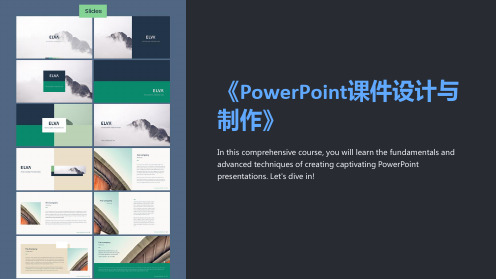
3 Pro Tips and Tricks
Discover lesser-known shortcuts and hidden features that can make a significant difference in your PowerPoint experience.
《PowerPoint课件设计与 制作》
In this comprehensive course, you will learn the fundamentals and advanced techniques of creating captivating PowerPoint presentations. Let's dive in!
PPT动画和转场特效
Animating Objects
Explore a variety of animation techniques to bring your presentations to life and engage your audience.
Transitions That Impress
内容组织和演讲技巧
1
Storytelling Techniques
Master the art of storytelling to engage your audience and convey your message effectively.
2
Creating Impactful Content
北师大版active learning教案(一)
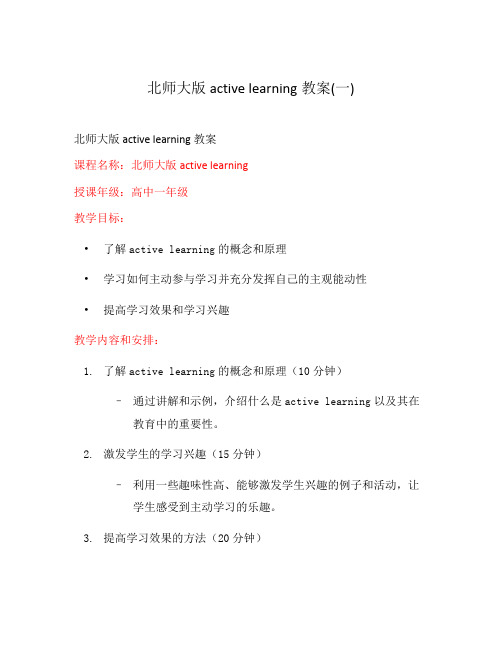
北师大版active learning教案(一)北师大版active learning教案课程名称:北师大版active learning授课年级:高中一年级教学目标:•了解active learning的概念和原理•学习如何主动参与学习并充分发挥自己的主观能动性•提高学习效果和学习兴趣教学内容和安排:1.了解active learning的概念和原理(10分钟)–通过讲解和示例,介绍什么是active learning以及其在教育中的重要性。
2.激发学生的学习兴趣(15分钟)–利用一些趣味性高、能够激发学生兴趣的例子和活动,让学生感受到主动学习的乐趣。
3.提高学习效果的方法(20分钟)–教授学生一些有效的学习方法,例如制定学习计划、合理安排学习时间、采取多种学习方式等,帮助学生主动管理和控制自己的学习过程。
4.培养学生的自主学习能力(25分钟)–引导学生寻找问题、解决问题的方法,并鼓励他们通过主动思考和积极参与,找到问题的答案。
5.提供学习资源和指导(15分钟)–介绍学生可以利用的各种学习资源,如图书馆、互联网等,并指导学生如何利用这些资源进行有效的学习。
教学方法:•讲解法:结合示例和讲解,介绍active learning的概念和原理。
•互动讨论:通过提问和学生间的互动讨论,激发学生的兴趣和主观能动性。
•小组活动:让学生进行小组活动,共同解决问题,培养合作意识和自主学习能力。
教学评价方式:•板书记录学生的思路和回答•对学生在小组活动中的表现进行观察和评估•布置作业,检查学生对课堂内容的掌握程度教学资源准备:•讲义、答题纸和笔•学习资源推荐列表•小组活动题目和奖励机制参考书目:•North Carolina Cooperative Extension. (2019). Active Learning Techniques. Retrieved from教学延伸:•组织学生参观有关active learning的实践案例,进一步加深学生对active learning的理解和认识。
北师大版active learning教案
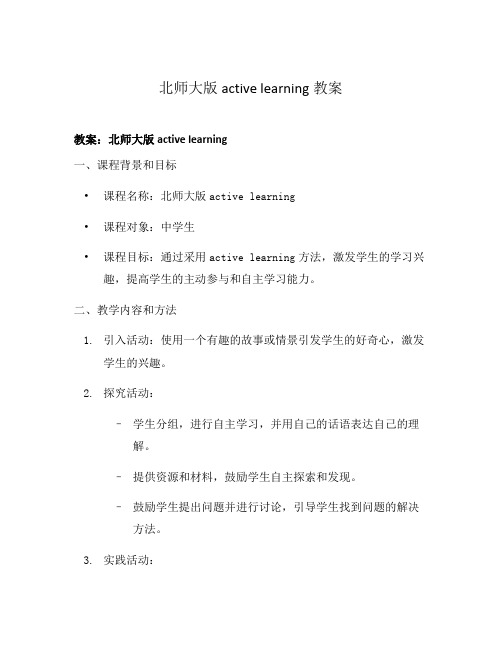
北师大版active learning教案教案:北师大版active learning一、课程背景和目标•课程名称:北师大版active learning•课程对象:中学生•课程目标:通过采用active learning方法,激发学生的学习兴趣,提高学生的主动参与和自主学习能力。
二、教学内容和方法1.引入活动:使用一个有趣的故事或情景引发学生的好奇心,激发学生的兴趣。
2.探究活动:–学生分组,进行自主学习,并用自己的话语表达自己的理解。
–提供资源和材料,鼓励学生自主探索和发现。
–鼓励学生提出问题并进行讨论,引导学生找到问题的解决方法。
3.实践活动:–学生进行实验、模拟、角色扮演等实践活动,将所学知识应用到实际中去。
–学生进行小组合作,共同完成各种任务和项目,并进行经验总结和分享。
4.反思活动:–学生进行个人或小组的自我评价,梳理学习过程中的优点和不足。
–整合反思结果,让学生认识到自己的进步和需要改进的地方。
三、教学步骤1.引入活动:通过一段精彩的视频或图片展示,引发学生的兴趣和好奇心。
2.探究活动:–学生分组,自主学习相关知识,并进行小组讨论。
–学生通过研究教材和其他资源,找出解决问题的方法。
–学生进行小组展示,分享自己的学习成果和发现。
3.实践活动:–学生根据所学知识设计实验,并进行实践操作。
–学生通过模拟活动或角色扮演,将所学知识应用到实际情境中。
–学生进行小组合作,共同完成项目,并进行经验总结和反思。
4.反思活动:–学生进行个人或小组的自我评价,梳理自己在学习过程中的表现和成果。
–学生分享自己的反思和感悟,互相学习和交流经验。
–教师进行总结和点评,鼓励学生进一步提高和发展。
四、评价和反馈•学生作品集:学生整理自己的学习成果和作品,用于展示和评估学生的表现。
•学生自评和互评:学生进行个人或小组的自我评价,并进行互相评价,加强学生对自己和他人的认知和理解。
•教师评价和反馈:教师根据学生的活动和表现,给予及时的评价和针对性的反馈,帮助学生不断提高。
高中英语必修件LessonActiveLearning
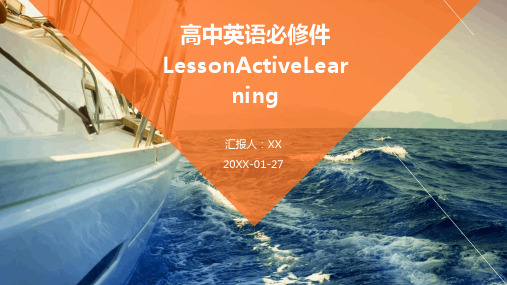
Key points of shorthand
During the listening process, use shorthand methods such as abbreviations and symbols to quickly record important information for subsequent review and organization.
• Listen and practice more: Through extensive listening practice, become familiar with listening materials on different topics and situations, and improve listening speed and accuracy. At the same time, engage in more oral practice to improve oral expression skills and promote the comprehensive improvement of listening and speaking abilities.
• Teaching methods: Textbooks should adopt various teaching methods, such as task-based teaching, situational teaching, etc., to stimulate students' interest and enthusiasm in learning.
Language skills
cultivate four basic skills of listening, speaking, reading, and writing, and improve comprehensive application ability.
创意黑板课堂课件教师公开课培训课件PPT

请替换文字内容
LOGO
CLASSROOM COURSEWARE COURSES FOR TEACHERS
感谢聆听,批评指导
2018
请替换文字内容,点击添加相关标题文字,修改文字内容,也可以直接复制你的内容到此。
请替换文字内容
请替换文字内容,点击添加相关标题文字,修改文字内容,也可以直接复制你的内容到此。
请替换文字内容
请替换文字内容,点击添加相关标题文字,修改文字内容,也可以直接复制你的内容到此。
请替换文字内容
请替换文字内容,点击添加相关标题文字,修改文字内容,也可以直接复制你的内容到此。
请替换文字内容,点击添加相关标题文字,修改文字内容,也可以直接复制你的内容到此。
请替换文字内容
请替换文字内容,点击添加相关标题文字,修改文字内容,也可以直接复制你的内容到此。
请替换文字内容
请替换文字内容,点击添加相关标题文字,修改文字内容,也可以直接复制你的内容到此。
请替换文字内容
请替换文字内容
LOGO
请替换文字内容请替换文字内容,点击添加相关标题文字,修改文字内容,也可以直接复制你的内容到此。
请替换文字内容
LOGO
13
请替换文字内容,点击添加相关标题文字,修改文字内容,也可以直接复制你的内容到此。
请替换文字内容
请替换文字内容,点击添加相关标题文字,修改文字内容,也可以直接复制你的内容到此。
请替换文字内容
请替换文字内容,点击添加相关标题文字,修改文字内容,也可以直接复制你的内容到此。
请替换文字内容,点击添加相关标题文字,修改文字内容,也可以直接复制你的内容到此。
《高效课件制作技巧-PPT制作必修课》
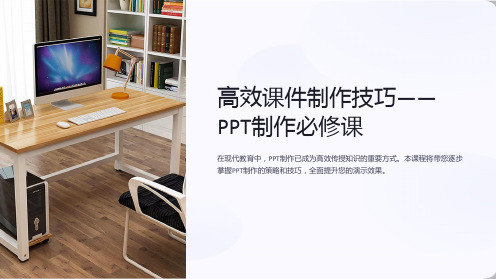
Be prepared and learn more about how to effectively create a successful presentation. Study the essential measures you have to take prior to developing your PPT project.
品质保证
避免视觉冲突,选择适当的搭配颜色
Find out how to avoid visual conflicts when adding colour to your designs; learn the right principles of selecting appropriate colour schemes.
PPT分享和交流的途径
Share and engage with your colleagues and peers through the use of various sharing and collaboration tools that will promote collaboration and improve learning outcomes.
Discover the techniques used by experienced presenters to customise their presentations and engage with diverse audiences.
3
制作PPT游戏和测试的方法
Master the techniques involved in creating PPT games and tests that keep audiences engaged and learning.
Unit 9 Learning Lesson 1 Active Learning(II) 课件

2.跟动词不定式作宾语的动词:
“决心学会想希望, ➢ decide/determine, learn, want, expect/hope/wish
拒绝设法愿假装” ➢ refuse, manage, volunteer, pretend
“主动答应选计划 ➢ offer, promise, choose, plan 同意请求帮一帮” ➢ agree, ask/beg, help
试着做某事
努力去做某事
意味着做某事
打算做某事
忍不住/情不自禁做某事 不能帮助做某事
继续做某事
做完一件事后接着做另 一件事
目标二:To use the V-ing form and infinitive verbs correctly in specific contexts
Activity 1: Compl form of the verbs in brackets.
Activity 2: Use a dictionary to help you and add the following verbs to the table above.
Can you find advise agree avoid can't stand doann'tymthiinndg?eAnjnody start help like manage practise regrethenseseomrt it roeumt.ember
Verb + verb-ing form
Verb + infinitive
advise, avoid, can't stand, don't agree, start, help, manage,
Learning Lesson 1 Active Learning教案
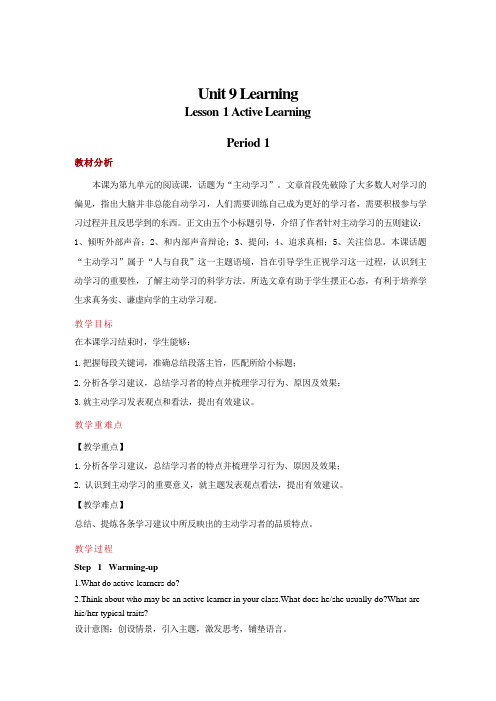
Unit 9 LearningLesson 1 Active LearningPeriod 1教材分析本课为第九单元的阅读课,话题为“主动学习”。
文章首段先破除了大多数人对学习的偏见,指出大脑并非总能自动学习,人们需要训练自己成为更好的学习者,需要积极参与学习过程并且反思学到的东西。
正文由五个小标题引导,介绍了作者针对主动学习的五则建议:1、倾听外部声音;2、和内部声音辩论;3、提问;4、追求真相;5、关注信息。
本课话题“主动学习”属于“人与自我”这一主题语境,旨在引导学生正视学习这一过程,认识到主动学习的重要性,了解主动学习的科学方法。
所选文章有助于学生摆正心态,有利于培养学生求真务实、谦虚向学的主动学习观。
教学目标在本课学习结束时,学生能够:1.把握每段关键词,准确总结段落主旨,匹配所给小标题;2.分析各学习建议,总结学习者的特点并梳理学习行为、原因及效果;3.就主动学习发表观点和看法,提出有效建议。
教学重难点【教学重点】1.分析各学习建议,总结学习者的特点并梳理学习行为、原因及效果;2. 认识到主动学习的重要意义,就主题发表观点看法,提出有效建议。
【教学难点】总结、提炼各条学习建议中所反映出的主动学习者的品质特点。
教学过程Step 1 Warming-up1.What do active learners do?2.Think about who may be an active learner in your class.What does he/she usually do?What are his/her typical traits?设计意图:创设情景,引入主题,激发思考,铺垫语言。
Step 2 Reading1.Read the first paragraph.Answer the following questions.设计意图:问题引导,厘清核心概念,为理解下文做铺垫。
2.Read the text.Match the subheadings with the corresponding paragraphs.设计意图:引导学生把握每段关键词,总结段落主旨。
- 1、下载文档前请自行甄别文档内容的完整性,平台不提供额外的编辑、内容补充、找答案等附加服务。
- 2、"仅部分预览"的文档,不可在线预览部分如存在完整性等问题,可反馈申请退款(可完整预览的文档不适用该条件!)。
- 3、如文档侵犯您的权益,请联系客服反馈,我们会尽快为您处理(人工客服工作时间:9:00-18:30)。
QuarterlyBusiness Communication DOI: 10.1177/108056990707000403042007; 70; 462 Business Communication Quarterly Elisabeth Gareis Active Learning: A PowerPoint Tutorial The online version of this article can be found at: Published by:On behalf of:Association for Business Communicationcan be found at:Business Communication Quarterly Additional services and information for/cgi/alerts Email Alerts:/subscriptions Subscriptions:/journalsReprints.nav Reprints: /journalsPermissions.nav Permissions:462BUSINESS COMMUNICATION QUARTERLY / December 2007SummaryIn each of the examples above,students actively participate in the learning process,take ownership for the information,and collaborate to understand and become knowledgeable about the content. The varied use of team activities as state changes during a class session helps students stay focused and involved. This result is well worth the instructional effort needed to prepare and manage an active class. ReferencesAllen,R. H. (2002). Impact teaching:Ideas and strategies for teachers to maximize student learning. Boston:Allyn & Bacon.Crawford,A. E.,Saul,E. W.,Mathews,S.,& Makinster,J. (2005). Teaching and learning strategies for the thinking classroom. New York:International Debate Education Association (Open Society Institute).Lisa E. Gueldenzoph is an associate professor of business education in the School of Business and Economics at North Carolina A&T State University in Greensboro. She received her PhD in higher education administration from Bowling Green State University in Ohio. Address correspondence to Lisa E. Gueldenzoph, School of Business and Economics, North Carolina A&T State University, 1601 East Market Street, Greensboro, NC 27411; email: lguelden@.ACTIVE LEARNING: A POWERPOINT TUTORIALElisabeth GareisBaruch CollegeMUCH HAS BEEN written about the pitfalls of presentation graph-ics. From rigidly structured PowerPoint slides filled with too much text to presenters in dark rooms being transfixed by the screen,pre-sentation graphics often alienate audiences and detract from rather than enhance messages (Godin,2001; Paradi,2003; Parker,2001; Schwartz,2003; Tufte,2003). On the flip side,presentation graphics can also be used to great advantage,improving clarity,making logi-cal structures more transparent,and illustrating complicated concep-tual material (DiSanza & Legge,2005).Individual or group presentations are common assignments in busi-ness communication courses,and many students use PowerPoint slides as audiovisual support. Frequently,curriculum constraints don’t allow instructors much time to teach effective design and delivery ofFOCUS ON TEACHING463 presentation graphics in their courses; guidelines in the form of minilectures or handouts often have to suffice. While some students heed the advice given,more often than not the guidelines don’t stick, and presentations feature slides that are too text heavy,difficult to read,or otherwise less than effective.To involve the students actively and engage them more deeply in the learning process,we designed an online tutorial that covers both the effective design and delivery of PowerPoint slides or similar pre-sentation graphics (Gareis & Belland,2006). The tutorial consists of units that highlight specific design or delivery guidelines. The units can be completed in sequence or independent of each other.The tutorial works by juxtaposing slides (for design comparison) and video clips (for delivery comparison) and asking users to select the slide or video clip they deem most effective. Once users have made their selection,the tutorial follows up with feedback for the specific issue at hand.For example,within the section on slide design,users first encounter a slide pair on the theme of simplicity (“keep it simple”). One slide features distracting animations,excessive use of color and font variety,and a background template unrelated to the presentation topic. The contrast slide has a clean and simple look. When users click on their slide of choice,they receive feedback on whether the choice was correct and on how to keep slide design simple.In addition to simplicity,the design section of the tutorial features the following topics:The 6×6 rule (i.e.,using a maximum of 6 words per line and 6 lines per slide),making slides easy to read (e.g.,using large font size and high contrast),focusing on visuals rather than text (e.g.,maps,photos,diagrams,and graphs),avoiding errors,and inserting blank slides (e.g.,when talk is not accompanied by a visual).To engage students actively in questions concerning the effective delivery of presentation graphics,the tutorial offers “good”and “bad”choices of video clips,each 1 to 2 minutes long. The first video clip pair,for example,focuses on the issue of practicing with audio-visual (A V) aids. The “bad”clip shows a presenter who attempts to present without having rehearsed with the technology at hand. We watch him choosing poor lighting,fumbling with the computer (say-ing things like “it worked fine on my machine at home”),and464BUSINESS COMMUNICATION QUARTERLY / December 2007 encountering a number of technical problems. The contrast video clip shows the same presenter practicing with the A V aids well before the presentation,making sure everything functions properly, and deciding on optimal settings.In addition to the video pairs on practicing with A V aids,the tutor-ial contains videos on how to speak with technique (including keeping eye contact,speaking extemporaneously,and using gestures),remain-ing in control (especially on not using the screen as teleprompter),mak-ing content clear,navigating smoothly between slides,and answering questions with skill (e.g.,repeating questions before answering them, rewinding to specific slides when needed,and creating extra slides in preparation for possible questions).The tutorial also provides advice on how to create an outline,delin-eates pros and cons of using PowerPoint,and lists further resources, including satirical and critical commentary on the medium,such as the Gettysburg Address as a PowerPoint presentation (Norvig,n.d.), the comedian Don McMillan’s take on ineffective slide design and delivery (McMillan,2006),and the artist David Byrne’s creative experimentation with the medium (Byrne,2003).The slides and video clips of the tutorial are based on the presenta-tion theme of the Universal Declaration of Human Rights(United Nations Commission of Human Rights,1948),a topic that is applica-ble to many fields of study,including international business communi-cation and the global marketplace. A self-grading quiz on the Universal Declaration of Human Rights is included in the tutorial as well.The tutorial can be used individually outside of class or in class as a springboard for discussion. It can be completed individually in about 45 minutes; if it is used in class,at least an hour and 15 min-utes should be set aside to allow for meaningful discussion of each element. Whether completed as an out-of-class assignment or together in class,instructors may follow up the activity with a work-sheet or quiz on the most essential elements of effective slide design and delivery,for example,asking students to discuss the benefits of the 6×6 rule or how to find quality visuals for their upcoming pre-sentations.Feedback from instructors has been very positive. Here are some examples:FOCUS ON TEACHING465•My students have used it and have been enthusiastic.•The tutorial makes you feel positive about the experience when you’re done,and that’s a real achievement for a support tool such as this one. The examples are clear and good.•I cringe when I see some of the presentations the students must endure in the lecture halls and online....I appreciate your cre-ative approach to the topic. The key points are right on target.•I particularly like the fact that you dare to make “bad”examples....I think it is those bad choices that students learn most from.•[My students] have already used it in the Master’s program with great success and they are now talking about doing their own version where they would film the students doing good and bad examples of presentations to really consolidate what they’ve been learning....So,thank you again!The tutorial is available at / tutorials/ powerpoint and is free.ReferencesByrne,D. (2003,September 11). Learning to love PowerPoint. Wired. Retrieved May 16, 2007,from /wired/archive/11.09/ppt1.htmlDiSanza,J. R.,& Legge,N. J. (2005). Business and professional communication:Plans, processes,and performance. Boston:Allyn & Bacon.Gareis,E.,(Writer,Director) & Belland,J. (Producer). (2006). Effective use of PowerPoint: Online Tutorial[Computer software]. Retrieved June 15,2007,from http://www /tutorials/powerpoint.Godin,S. (2001). Really bad PowerPoint (and how to avoid it).Retrieved May 16,2007,from /freeprize/reallybad.htmlMcMillan,D. (Director). (2006). Life after death by PowerPoint.Retrieved May 16,2007,from /index.cfm?fuseaction=vids.individual&videoID=15296 37984 Norvig,P. (n.d.). The Gettysburg PowerPoint presentation. Retrieved May 16,2007,from /Gettysburg/Paradi,D. (2003). Ten secrets for using PowerPoint effectively. Retrieved May 16,2007,from /articles/ten_secrets_for_using_powerpoint.htm Parker,I. (2001,May 28). Absolute PowerPoint. The New Yorker,pp. 76-86. Retrieved May 16,2007,from LexisNexis database.Schwartz,J. (2003,September 28). The level of discourse continues to slide. The New York Times,Week in Review,p. 12. Retrieved May 16,2007,from / 2003/09/28/weekinreview/28SCHW.html?ex=1380081600&en=5d03829b0c77621a&ei= 5007&partner=USERLANDTufte,E. (2003,September 11). PowerPoint is evil. Wired.Retrieved February 18,2007,from /wired/archive/11.09/ppt2.htmlUnited Nations Commission of Human Rights. (1948). Universal declaration of human rights.(1948). Retrieved May 16,2007,from http://www.unhchr.ch/udhr/lang/eng.htm466BUSINESS COMMUNICATION QUARTERLY / December 2007Elisabeth Gareis is an associate professor in the Department of Communication Studies at Baruch College/City University of New York. She teaches intercultural com-munication, international communication, and conflict resolution, and coordinates a number of English-as-second-language services in oral communication at the college. Address correspondence to Elisabeth Gareis, Department of Communication Studies, Baruch College, Box B8-240, 55 Lexington Avenue, New York, NY 10010; email: egareis@.REAL-TIME COMPUTER-MEDIATED COMMUNICATION: EMAIL AND INSTANT MESSAGING SIMULATIONAmy NewmanCornell UniversityAS COMPUTER-MEDIA TED COMMUNICA TION becomes increas-ingly prevalent in the workplace,students need to apply effective writing principles to today’s technologies. Email,in particular, requires interns and new hires to manage incoming messages,use an appropriate tone,and craft clear,concise messages. In addition,with instant messaging (IM) making its way into corporate communica-tion (Osterman,2006),students are further challenged to transition from IM with friends to IM with professional colleagues.Our business communication courses are an ideal place for students to learn and practice new ways to write for these technolo-gies. While instructors can teach basic principles by having students compose and analyze emails,these methods lack the organizational context and real-world pressures of handling volume correspon-dence at work.A technology-based simulation allows students to test their writ-ing skills within a realistic,real-time environment,within which they make decisions about whether and how to respond to messages based on organizational culture,the sender’s position relative to their own,and the urgency and relevance of a message.Simulation OverviewFor undergraduates,I developed a simulation set at Writeaway H otels,a fictitious organization. The simulation is facilitated in a computer lab,with students sitting at individual monitors. During the 30-minute session,students prioritize,respond to,and evaluate。
